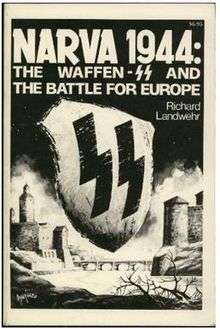Richard Landwehr

Richard Landwehr is the author of numerous books about the Waffen-SS, its non-German volunteers in particular, providing revisionist and apologetic accounts of these men and their battles. He has been producing the magazine Siegrunen on the same topic for over 30 years. Landwehr has written for the Journal for Historical Review (JHR) which is published by the Institute for Historical Review, an American Holocaust denial organization.
Criticism
Historians criticize Landwehr's works for their revisionist, apologetic portrayal of Waffen-SS.
- The military historian S.P. MacKenzie describes Landwehr as an "extreme admirer [from] the fringes of the far-right."[2]
- Dr. van Hoesel's 1948 study (cited in both George Stein's "The Waffen SS" and Henry L. Mason's 1952 "Purge of the Dutch Quislings") of 450 Dutch SS volunteers revealed some joined to avoid prosecution for petty crime or delinquency. Others joined out of boredom and a desire for adventure, some for prestige, better food or to avoid labour service.
- The records left by the Nazis themselves serves to contradict Landwehr's misleading image of the idealistic European SS volunteer. Stein notes that Gottlub Berger, who dealt with foreign volunteers, was aware of the prevalence of criminal elements and noted that "many criminals are quite outstanding soldiers if one knows how to handle them" (Berger to Gruppenfuhrer Rauter, April 9, 1942, Geheim, RFSS/T-175, 111/2635463ff.).
- In A European Anabasis - Western European Volunteers in the German Army and SS 1940 - 1945, historian Kenneth Estes authoritatively documented the motivations of the western European volunteers and came to markedly different conclusions than those of Landwehr.
MacKenzie connects Landwehr with the contemporary Waffen-SS historical revisionism, first propounded by HIAG, the Waffen-SS lobby group from the 1950–1990s. Commenting on this contemporary trend, Mackenzie writes that "as older generation of Waffen-SS scribes has died off, a new, post-war cadre of writers has done much to perpetuate the image of the force as a revolutionary European army" and includes Landwehr in this group.[3]
Works
- Estonian Vikings: Estnisches SS-Freiwilligen Bataillon Narwa and Subsequent Units, Eastern Front, 1943-1944 ISBN 1-899765-09-3
- Lions of Flanders: Flemish Volunteers of the Waffen-SS, 1941-1945 ISBN 1-899765-03-4
- Budapest: The Stalingrad of the Waffen-SS ISBN 1-57638-129-3, (Hardcover), ISBN 1-57638-128-5
- Fighting for Freedom: The Ukrainian Volunteer Division of the Waffen-SS ISBN 0-918184-05-3
- Lions of Flanders: Flemish Volunteers of the Waffen-SS 1941-1945 with Ray Merriam & Ramiro Bujeiro (Illustrator) ISBN 0-918184-04-5
- Narva, 1944: The Waffen-SS and the Battle for Europe ISBN 0-918184-02-9
- Nordic Warriors: SS-Panzergrenadier Regiment 24 Danmark, Eastern Front,1943-45 with Holger Thor Nielsen ISBN 1-899765-07-7
- Steadfast Hussars: The Last Cavalry Divisions of the Waffen-SS ISBN 1-57638-105-6 Hardcover, ISBN 1-57638-130-7
- The Wallonien: The History of the 5th SS-Sturmbrigade and 28th SS Volunteer Panzergrenadier Division with Ray Merriam and Jean-Louis Roba ISBN 1-57638-088-2
See also
References
Citations
- ↑ Werther & Hurd 2014.
- ↑ MacKenzie 1997, p. 139.
- ↑ MacKenzie 1997, pp. 139–140.
Bibliography
- MacKenzie, S.P. (1997). Revolutionary Armies in the Modern Era: A Revisionist Approach. New York: Routledge. ISBN 978-0-415-09690-4.
- Werther, Steffen; Hurd, Madeleine (2014). "Go East Old Man: The Ritual Spaces of SS Veteran's Memory Work" (PDF). Culture Unbound. Journal of Current Cultural Research. 6: 327–359. Archived from the original (PDF) on 2016-01-02.